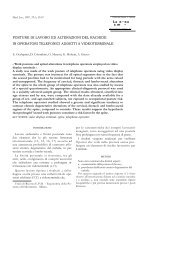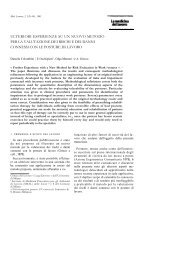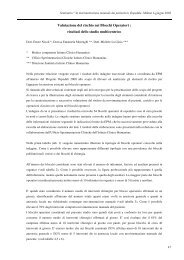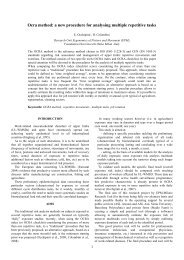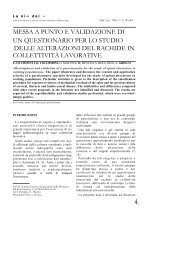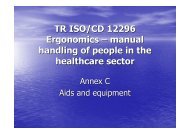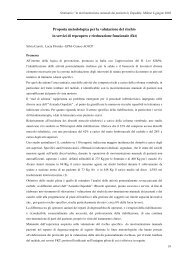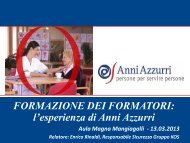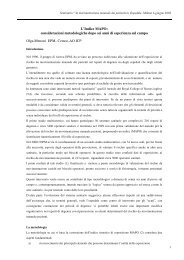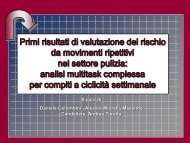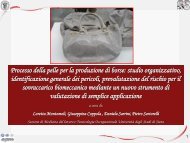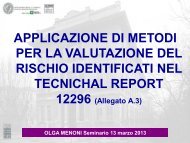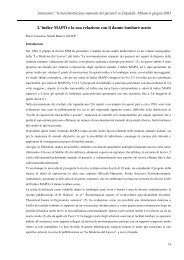Muscular effort and musculo-skeletal disorders in piano students - epm
Muscular effort and musculo-skeletal disorders in piano students - epm
Muscular effort and musculo-skeletal disorders in piano students - epm
Create successful ePaper yourself
Turn your PDF publications into a flip-book with our unique Google optimized e-Paper software.
ERGONOMICS, 1989, VOL. 32, No. 7, 697-716<strong>Muscular</strong> <strong>effort</strong> <strong>and</strong> <strong>musculo</strong>-<strong>skeletal</strong> <strong>disorders</strong> <strong>in</strong> <strong>piano</strong> <strong>students</strong>:electromyographic, cl<strong>in</strong>ical <strong>and</strong> preventive aspectsA. GRIECO, E. OCCHIPINTi, D. COLOMBINI, O. MENONI,M. BULGHERONI, C. FRIGO <strong>and</strong> S. BOCCARDI`Ergonomics of Posture <strong>and</strong> Movement'—EPM—Research Unit,c/o Cl<strong>in</strong>ica del Lavoro 'Luigi Devoto', Via San Barnaba 8,20122 Milano, ItalyKeywords: Musculo-<strong>skeletal</strong> <strong>disorders</strong>; Piano players; Electromyography; Physicaleducation; Tra<strong>in</strong><strong>in</strong>g.An <strong>in</strong>vestigation was made on the relationship between music practice <strong>and</strong><strong>musculo</strong>-<strong>skeletal</strong> <strong>disorders</strong> among <strong>piano</strong> <strong>students</strong>, with the ma<strong>in</strong> aim of develop<strong>in</strong>ghealth education programmes that would improve the performance <strong>and</strong> health ofthe <strong>students</strong>.The <strong>in</strong>vestigation covered three areas:(a) Analysis of study organization <strong>and</strong> ma<strong>in</strong> <strong>musculo</strong>-<strong>skeletal</strong> compla<strong>in</strong>tsachieved by a questionnaire distributed to ali <strong>piano</strong> <strong>students</strong> at the MilanConservatory.(b) Vocational electromyographic analysis of the <strong>effort</strong> exerted by the variousmuscle groups of the trunk, of the shoulder <strong>and</strong> shoulder biade girdle, <strong>and</strong> ofthe arra dur<strong>in</strong>g performance of a st<strong>and</strong>ard set of <strong>piano</strong> exercises, an unseenpassage <strong>and</strong> a passage of maximum difficulty. This analysis was made on asample of six subjects.(c) A series of preventive measures was developed on the basis of a criticaiassessment of the results (38% of the <strong>students</strong> practised for excessively longperiods without breaks; 62% had from 1 to 5 compla<strong>in</strong>ts, the most affectedsites be<strong>in</strong>g the sp<strong>in</strong>e <strong>and</strong> the trapezius muscles). These consisted largely of ahealth education programma aimed at help<strong>in</strong>g the <strong>students</strong> to suitablyorganze practice <strong>and</strong> resi periods <strong>and</strong> <strong>in</strong> <strong>in</strong>struct<strong>in</strong>g them <strong>in</strong> appropriateexercises for relaxation <strong>and</strong> stretch<strong>in</strong>g of overused muscle groups <strong>and</strong>strengthen<strong>in</strong>g the support<strong>in</strong>g muscle groups. Changes <strong>in</strong> lifestyle avere alsosuggested.L IntroductionRecent literature is poorly lack<strong>in</strong>g <strong>in</strong> data on osteo-muscular <strong>disorders</strong> among pianista.The alterations most frequently attributed to <strong>piano</strong> practice are tend<strong>in</strong>itis of the h<strong>and</strong><strong>and</strong> forearm muscles <strong>and</strong> nerve compression which often manifests as a carpal tunnelsyndrome (Clark 1986).Paradoxically, the most detailed literature on the subject goes back to the lastcentury, with a description of `pianist's cramp' that was identical to the perhaps batterknown writer's <strong>and</strong> telegrapher's cramp. At that time, the condition was the subject ofampie discussion as to its etiopathogenesis <strong>and</strong> cl<strong>in</strong>ical def<strong>in</strong>ition which can <strong>in</strong> eachcase be identified as orig<strong>in</strong>at<strong>in</strong>g from overuse of the <strong>musculo</strong>-tend<strong>in</strong>eous structures ofthe forearm <strong>and</strong> h<strong>and</strong>, which manifests, usually <strong>in</strong> an acute or recurrent forra, with pa<strong>in</strong>,weakness <strong>and</strong> loss of co-ord<strong>in</strong>ation <strong>and</strong> control (up to a transitory paretic-likecondition), accompanied <strong>in</strong> some casca by excessive locai sweat<strong>in</strong>g.0014-0139/89 $3 . 00 (0 1989 Taylor & Francia Ltd.
71 698 A. Grieco et al.PIOn the basis of these bibliographic references of 100 years ago, Australian authorsrecognized the close similarities between pianist's cramp <strong>and</strong> the `overuse syndrome'def<strong>in</strong>ed as `those changes brought about <strong>in</strong> the muscles <strong>and</strong> jo<strong>in</strong>t ligaments fromexcessive use, caus<strong>in</strong>g pa<strong>in</strong>, loss of function, <strong>and</strong> almost always demonstrabletenderness <strong>in</strong> the affected structures'. (Fry 1986, 1987).In a study made <strong>in</strong> seven of Australia's 11 music schools, cover<strong>in</strong>g 409 <strong>piano</strong><strong>students</strong>, it was found that 9% of the <strong>students</strong> were affected by the overuse syndrome to amore or less marked degree. The syndrome was much more frequent <strong>in</strong> females (7%) than<strong>in</strong> males (2%). The saure author reported that the overuse syndrome affects morethan 50% of the musicians <strong>in</strong> modern Symphony orchestrar <strong>in</strong> Australia.There has been a tendency to dem<strong>and</strong> <strong>in</strong>creas<strong>in</strong>g technical performance frommodern concert <strong>piano</strong>s. The Grober concert <strong>piano</strong> of the early 19th century <strong>in</strong>volvedabout 6 mm travel of the key <strong>and</strong> required a force of about 23 g to depress the key, with atension of the middle str<strong>in</strong>g section of 12 to 15 kg, whereas the modern Ste<strong>in</strong>way<strong>in</strong>volver about 10 . 5 mm travel, a depression pressure of about 50 to 60 g <strong>and</strong> 90 kgtension (Fry 1986).On the basis of these observations, we undertook an <strong>in</strong>vestigation which had thefollow<strong>in</strong>g aims:1. Estimate the frequency of <strong>disorders</strong> of the locomotor apparatus <strong>in</strong> <strong>piano</strong><strong>students</strong> of the Milan Conservatory.2. Assess the <strong>effort</strong> of various muscle groups dur<strong>in</strong>g <strong>piano</strong> practice by means ofvocational electromiography techniques, <strong>and</strong> also o utl<strong>in</strong>e a mode) fororganization of practice dur<strong>in</strong>g the week.3. Identify prevention measures, with particular emphasis on ways to change<strong>students</strong>' <strong>in</strong>dividua) attitudes <strong>and</strong> tra<strong>in</strong> them <strong>in</strong> suitable mobilization, relaxation<strong>and</strong> stretch<strong>in</strong>g exercises.2. Methods2.1. Analysis of study day organization <strong>and</strong> analysis of <strong>musculo</strong>-<strong>skeletal</strong> <strong>disorders</strong>A specially developed questionnaire was used, divided f<strong>in</strong>to three parts, i.e.:(a) generai <strong>in</strong>formation <strong>and</strong> features of organization of study <strong>and</strong> free time;(b) occurrence, site, <strong>and</strong> characteristics of any <strong>musculo</strong>-<strong>skeletal</strong> <strong>disorders</strong>;(c) occurrence of psychic, respiratory or digestive compla<strong>in</strong>ts.A total of 117 completed questionnaires were collected (54 males <strong>and</strong> 63 females),equivalent to a response rate of about 75% of the <strong>students</strong> contacted. The compositionof the respondents, by age class, is shown <strong>in</strong> table I.2.2. Electromyographic study2.2.1. subjects: The electromyographic study covered six <strong>piano</strong> <strong>students</strong> (three males<strong>and</strong> three females) enrolled for the f<strong>in</strong>a) years of the course. The subjects participated <strong>in</strong>the experiment voluntarily. Generai anthropometric parameters (weight, height) weremeasured for all subjects, plus a number of specific parameters of the h<strong>and</strong> such asbreadth, length of the third f<strong>in</strong>ger, length of the h<strong>and</strong> at the third f<strong>in</strong>ger, angles betweenf<strong>in</strong>gers at maximum aperture. The relative percentile was calculated for all parameters.2.2.2. Selected <strong>piano</strong> exercises: In order to st<strong>and</strong>ardize the exercises performed by thesix subjects, a set of st<strong>and</strong>ard exercises of vary<strong>in</strong>g difficulty was selected, each <strong>in</strong>volv<strong>in</strong>g
<strong>Muscular</strong> <strong>effort</strong> <strong>and</strong> <strong>musculo</strong>-<strong>skeletal</strong> <strong>disorders</strong> <strong>in</strong> <strong>piano</strong> <strong>students</strong> 699Table I. Distribution of <strong>piano</strong> <strong>students</strong> exam<strong>in</strong>ed via questionnaire, by age class <strong>and</strong> years ofstudy.Age classyearsNumberYears of studySC8-10 9 211-13 26 3.914-16 29 6.117-19 21 9.2620-22 20 11.223-25 8 10.8>25 4 16.5Total number of subject exam<strong>in</strong>ed N=117.a different use of the h<strong>and</strong>/forearm system. The exercises were taken from Hanon (aclassic volume of preparatory exercises widely used <strong>in</strong> <strong>piano</strong> teach<strong>in</strong>g) <strong>and</strong> wereclassified <strong>in</strong> groups accord<strong>in</strong>g to the different aspects of muscular <strong>effort</strong> (figure 1). Eachexercise was performed at two speeds: (a) the m<strong>in</strong>imum speed for the score; (b) thestudent's maximum possible speed. Also, each subject performed an unseen passage(Scott Jopl<strong>in</strong>'s 'Elite Syncopation') which was played aga<strong>in</strong> after 15 m<strong>in</strong> practice.Each student then performed one or two passages from his/her repertoire whichhe/she considered to be the most difficult. Here, it was obviously not possible tost<strong>and</strong>ardize the exercises so no comparison could be made, except for the Tirstvariation on a theme of Pagan<strong>in</strong>i-Brahms', which all three male <strong>students</strong> performed.2.2.3. Vocational electromyography: The process<strong>in</strong>g method used was derived fromJonsson (1982), <strong>and</strong> is based on the def<strong>in</strong>ition of the probability distribution function ofmyoelectric signal amplitude. Accord<strong>in</strong>g to Jonsson, the static, maximum peak <strong>and</strong>median load levels can be identified on the amplitude distribution cumulative curves.Studies by Bjórksten <strong>and</strong> Jonsson (1977) on resistance to fatigue <strong>in</strong> exercises repeatedfor vary<strong>in</strong>g lengths of time, led to the def<strong>in</strong>ition of maximum limits for static, median<strong>and</strong> peak load values that may be summarized as follows: static load should not exceed2-5% of the maximum voluntary contraction, median load 10-14% <strong>and</strong> peak load50-70%.In the present study we exam<strong>in</strong>ed eight groups of muscles, i.e., right upper trapezius,right deltoideus, right biceps, right forearm muscles (epicondyle), right forearm muscles(epitrochlea), right lumbar erector, first <strong>in</strong>terosseus dorsalis of the right h<strong>and</strong>, left uppertrapezius.Myoelectric signals were obta<strong>in</strong>ed us<strong>in</strong>g superficial electrodes connected to atelemetric electromyograph. The signal was then rectified <strong>and</strong> analogically <strong>in</strong>tegrateti<strong>and</strong> transmitted to an IBM/AT personal computer. The software specially developedto obta<strong>in</strong> <strong>and</strong> process the signals <strong>in</strong> rea) time also <strong>in</strong>cluded simultaneous on-l<strong>in</strong>evisualization of the eight electromyoelectrographic signals. F<strong>in</strong>a) graphicrepresentation <strong>and</strong> subsequent statistica) analysis were performed at the enti of theexperimental session on the memorized data.For each subject, myoelectric activity of each muscle was prelim<strong>in</strong>arily recordeddur<strong>in</strong>g maximum voluntary contraction (MVC) aga<strong>in</strong>st resistance. Figure 2 illustratesthe operation required to record the MVC of the epicondyle muscle group.
7N1A) Exercisesof scales& arpeggios,,,„,rA"8) Exercisesof octaves5139r,41Exercisesof notes repeated3x3 <strong>and</strong> trill44pagm fgr FAMMI! ELICTICErel CUCIMICI(W4-C) Exercisesof alternateoctave scale & tremolo&6- -3 ---- A5660m»s=mmM~ í48go - M –M=nng a r z a = g = c wD) exercisesof terz<strong>in</strong>astaccataOunwa g anagi,ffildir= A= mwiFigure I.Examples of Hanon exercises <strong>and</strong> theirgroup<strong>in</strong>g.Figure 2. Operation required to record MVC of epicondyle muscle group.
<strong>Muscular</strong> <strong>effort</strong> <strong>and</strong> <strong>musculo</strong>-<strong>skeletal</strong> <strong>disorders</strong> <strong>in</strong> <strong>piano</strong> <strong>students</strong> 701Activity of the eight muscle groups under study was recorded cont<strong>in</strong>uously dur<strong>in</strong>g<strong>piano</strong> practice; by means of sample record<strong>in</strong>gs at a frequency of 300 per second, weobserved the number of times the sample record<strong>in</strong>gs reached saturation <strong>in</strong> rangescorrespond<strong>in</strong>g to set percentages (at <strong>in</strong>tervals of five) compared to the MVC. Figure 3Aillustrates the result of this procedure: over the total samples, which represented thewhole exercise, it is possible to establish the percentage of time a given muscle hasworked <strong>in</strong> the different classes of <strong>effort</strong> compared to the MVC. The percentage level of<strong>effort</strong> compared to MVC is shown on the x-axis <strong>and</strong> the percentage of time compared tototal practice time is given on the y-axis. In figure 313 the frequencies of the variouslevels of <strong>effort</strong> compared to total time are represented by the cumulative curve ofamplitude distribution, which also shows the key levels for <strong>in</strong>terpretation of muscular<strong>effort</strong>. Further elaboration of the results will <strong>in</strong>clude the plott<strong>in</strong>g of curves which will beidentica) for the <strong>in</strong>dividua) muscles, <strong>in</strong> s<strong>in</strong>gle or group tests for groups of subjects, withdef<strong>in</strong>ition of the relative statistica) parameters (mean, st<strong>and</strong>ard deviation).3. Results3.1. Organization of practice daysTable 2 summarizes the ma<strong>in</strong> data obta<strong>in</strong>ed via the questionnaire, <strong>in</strong> particular themean practice time weekly <strong>and</strong> on each day of the week for the <strong>students</strong> divided f<strong>in</strong>tothree age classes (which more or less correspond to the course levels). Hours of practiceper week ranged from 14 <strong>in</strong> the youngest <strong>students</strong> to nearly 30 <strong>in</strong> the older age class. Onthe whole, distribution of hours of practice was homogeneous: only 15 <strong>students</strong> (about13%) distributed <strong>piano</strong> practice over the week <strong>in</strong> an extremely non-homogeneousmanner, <strong>and</strong> they avere all between 15 <strong>and</strong> 19 years of age. This could be due to thepressure of secondary school study.0.80AAm p litude d i s t r i b u t i o n c u m u l a t i v e curveTimeTime0.80Peaklevel0.670.530400.67~0.53 -..Staticleve l0.270.40 -0.13oUleve l0000.13edi20 30 40 50an10 20 30 4 W % MCV i0.00%MCsam Vp l e s o v e r 7 5 % o f M V C : ì % 0 . 1 P r o b a b i l i t y : 7 % M V C ( r e c o m m e n d e d v a l u e 5 % ) CAprobability:18% MVC (recommended value 14%) 0.9Probability:33% MVC (recommended value 70%)Figure 3. Amplitude distribution (A) <strong>and</strong> cumulative amplitude distribution (B) of samples ofEMG signals dur<strong>in</strong>g a vocational EMG record<strong>in</strong>g test. In (B) the broken l<strong>in</strong>es representthe static, median <strong>and</strong> peck levels aga<strong>in</strong>st which the obta<strong>in</strong>ed results can be evaluated.
702 A. Grieco et al.Table 2. Distribution of hours of <strong>piano</strong> practice (A) over the week <strong>and</strong> distribution of breaks(B).(A) Mean distribution of hours of practice per week.Ageclassyears Mon Tues Wed Thurs Fri Sat Sun Total8-13 1h41' 2h54' 2 h 6 ' 1h39' 2 h 7 ' 2 h43 ' 2 h10 ' 15h20'14-19 3h 14' 2h 53' 3h 18' 3h 36' 2h 18' 3h 20' 3h 52' 22 h 31'>19 4h 33' 3h 56' 4h 23' 4h 29' 3h 44' 4h 21' 3h 54' 29h20'Total 3 h 10' 3h 11' 3 h 16' 3 h 17' 2h 38' 3h 27' 3 h 23' 22 h 20'(B) Distribution of breaks.Number of subjectstak<strong>in</strong>g breaks 96 82% (out of 117)*Mean durationof breaksInterval betweenbreaks11 m<strong>in</strong>70 m<strong>in</strong>* 21 do not take breaks, 17 take breaks bue every 2 or more hours.N<strong>in</strong>ety-six subjects (82%) took breaks dur<strong>in</strong>g <strong>piano</strong> practice last<strong>in</strong>g on average11 m<strong>in</strong> <strong>and</strong> taken at an average <strong>in</strong>terval of 70 m<strong>in</strong>. However, some <strong>students</strong> took breaksevery 2 h or more (N = 17); comb<strong>in</strong><strong>in</strong>g these subjects with those who did not take breaks(N = 21), gave a total of 38 subjects (32%) who practised for excessively long periodswithout breaks. This percentage, along with the number of hours of study, <strong>in</strong>dicates theexistence of relatively high loads, especially consider<strong>in</strong>g the age of the subjects.3.2. Musculo-<strong>skeletal</strong> <strong>disorders</strong>Table 3 reports the number <strong>and</strong> prevalente of subjects without compla<strong>in</strong>ts (38%) <strong>and</strong>those with one to five compla<strong>in</strong>ts (62%). The percentage is surpris<strong>in</strong>gly high <strong>and</strong> thepercentage of subjects (about 14%) who had <strong>disorders</strong> affect<strong>in</strong>g three or more sites isalso significane.Table 3. Prevalente of subjects with one or more <strong>disorders</strong> of the locomotor apparatus.DistributionNumberPercentageof <strong>in</strong>terviewees(N=117)Subjects without <strong>disorders</strong> 45 38.4Subjects with 1 disorder 30 25.6Subjects with 2 <strong>disorders</strong> 23 19.6Subjects with 3 <strong>disorders</strong> 9 7.6Subjects with 4 <strong>disorders</strong> 6 5.1Subjects with 5 <strong>disorders</strong> 2 1.7Subjects with at least 1 disorder 72 61.5
Table 4. Site, forra of onset <strong>and</strong> characteristics of the most commonly reported <strong>disorders</strong> of the locomotor apparatus.Disorder Lumbar Dorsal CervicalUppe rTrapezius Shoulders Forearms WristsNumber of subjects 22 19 21 15 9 16 10with disorder* (109; 123) (119; 83) (99; 123) (11q; 4 ó ) (59; 4J) (9Y; 73) (59; 53)Percentage of 117 19 16 18 13 8 14 8When 01 at 4% 5% 5% 6% 11% 25% 40%No. % beg<strong>in</strong>n<strong>in</strong>g (of 20)0218% 16% 15% 27% 44% 50% 40%after 1 h0464% 64% 68% 60% 44% 19% 10%after 2 h08when notplay<strong>in</strong>g23% 10% 25% 13% 11% 6% 40%For how 1 year 47% 47% 25% 46% 25% 33% 40%long (of 19) (of 17) (of 20) (of 13) (of 8) (of 15)2 year 26%. 17% 20% 15% 25% 27% 10%3 year 21% 35% 45% 15% 25% 7% 30%4 year 5% 5% 15% 13% 10%
704 A. Grieco et al.Table 4 analyses <strong>in</strong> more detail the site, forra <strong>and</strong> time of onset, <strong>and</strong> thecharacteristics of the most frequently reported compla<strong>in</strong>ts of the locomotor apparatus.There was a high prevalence of <strong>disorders</strong> affect<strong>in</strong>g ali segments of the sp<strong>in</strong>e <strong>and</strong> thetrapezius muscles. Onset was also typical: sp<strong>in</strong>ai <strong>disorders</strong> appeared <strong>in</strong> the majority ofcases (more than 60%) after 2 h of <strong>piano</strong> practice. Pa<strong>in</strong>ful wrists <strong>and</strong> forearms, whichalso showed a significane prevalence (8% <strong>and</strong> 14%), tended to appear <strong>in</strong> the majority ofcases (75-80%) <strong>in</strong> the <strong>in</strong>itial phases of practice. In many cases there was a history ofseveral years (from 2 to 4 years) <strong>and</strong> the subjects generally compla<strong>in</strong>ed of a sense ofdiscomfort, or a sense of heav<strong>in</strong>ess or stiffness of the site <strong>in</strong>volved.A more detailed analysis of the <strong>disorders</strong> is made <strong>in</strong> Table 5, which reports thepercentages of subjects <strong>in</strong> whom the compla<strong>in</strong>t was judged to be serious accordipg tothe follow<strong>in</strong>g criteria:(a)Disorders of the sp<strong>in</strong>e, trapezius muscles, <strong>and</strong> shoulders when:appear<strong>in</strong>g at the beg<strong>in</strong>n<strong>in</strong>g of practice appear<strong>in</strong>g<strong>in</strong>dependently of hours of practice dist<strong>in</strong>ct pa<strong>in</strong> isfelttherapeutic treatment is necessary(b) Disorders of the forearm <strong>and</strong> wrists when:appear<strong>in</strong>g <strong>in</strong>dependently of hours of practicedist<strong>in</strong>ct pa<strong>in</strong> is felttherapeutic treatment is necessary.The percentage of subjects with serious <strong>disorders</strong> is certa<strong>in</strong>ly not negligible <strong>and</strong> <strong>in</strong> somecases (lumbar <strong>and</strong> cervical sp<strong>in</strong>e, wrists) represents a considerable portion (41-70%) ofthe subjects who had any compla<strong>in</strong>ts <strong>in</strong> these sites.Table 6 summarizes the range of therapeutic treatment for osteo -muscularcompla<strong>in</strong>ts: massage was the most frequently used treatment, with or without otherforms of physical therapy.3.3. <strong>Muscular</strong> <strong>effort</strong>3.3.1. Warm-upexercises:Forthesakeofbrevity,onlytheresultsofgroupsofexercisesgrouped accord<strong>in</strong>g to their similarity <strong>in</strong> muscular <strong>effort</strong> of the upper limbs are reported <strong>and</strong>discusseti. Referente is made <strong>in</strong> particular to exercises performed at maximumTable 5. Site <strong>and</strong> prevalence of serious <strong>disorders</strong>.NumberPercentageof 117Percentageof subjectswith <strong>disorders</strong>Lumbar 9 8 41Dorsal 6 5 32cervical 10 9 48Trapezius 5 4 33shoulders 2 2 22Forearms 4 3 25Wrists 7 6 70
<strong>Muscular</strong> <strong>effort</strong> <strong>and</strong> <strong>musculo</strong>-<strong>skeletal</strong> <strong>disorders</strong> <strong>in</strong> <strong>piano</strong> <strong>students</strong> 705Table 6.Use of therapeutic treatment among <strong>piano</strong> <strong>students</strong>.PercentagePercentageType of of <strong>in</strong>terviewees of subjectstreatment Number (N= 117) with <strong>disorders</strong>Drugs 3 2.6 4.2Massage 11 9.4 15.3Ultrasound 4 3.4 5.5ThermotherapyAcupuncture 3 2.6 4.2speed. Data on the first web-space muscle are not always reported s<strong>in</strong>ce <strong>in</strong> some casesdifficulties <strong>in</strong> record<strong>in</strong>g the signal arose dur<strong>in</strong>g the tests.Table 7 summarizes the types of movements or attitudes that were prevalentlyencountered <strong>in</strong> the various exercises or groups of exercises under study. Table 8summarizes, for all subjects <strong>and</strong> by sex, the cases <strong>and</strong> the groups of muscles where anexcessive static <strong>and</strong> median load<strong>in</strong>g occurred. Figure 4 reports, for the total number ofsubjects <strong>and</strong> for subjects divided by sex, the results of vocational electromyographyobta<strong>in</strong>ed by pool<strong>in</strong>g all the exercises performed at maximum speed, which thussatisfactorily represent the warm-up phase preced<strong>in</strong>g the study of a score.Taken as a whole, the results reveal:(1) the deltoid <strong>and</strong> bicipital muscles show a rather low level of <strong>effort</strong>,(2) <strong>effort</strong> of lumbar erector <strong>and</strong> trapezius muscles <strong>and</strong> of the muscles of theepitrochlea group was more conspicuous even though on the whole with<strong>in</strong>acceptable levels,(3) <strong>effort</strong> of trapezius muscles was on the whole asymmetric (with a tendency togreater <strong>effort</strong> of the left trapezius), but this is ma<strong>in</strong>ly due to the contribution ofthe ferrale sex; <strong>in</strong> the males both trapezius muscles were <strong>in</strong>volved <strong>in</strong> an identicalmanner with respect to static <strong>and</strong> median load<strong>in</strong>g, while for peck load<strong>in</strong>g therewas by far greater <strong>in</strong>volvement on the right,Table 7. Effort of anatomic structures for various exercises considered.ExercisesNotesAlternaterepeatedoctaveScales <strong>and</strong> 3 x 3 <strong>and</strong> scale <strong>and</strong> Terz<strong>in</strong>aMa<strong>in</strong> movement <strong>in</strong>volved arpeggios trill Octaves tremolo staccataFlexion/extension of f<strong>in</strong>gersAdduction/abduction of f<strong>in</strong>gersAdduction of thumbMovement of arms on lateral pianeLateral movement of trunkMaximum aperture of f<strong>in</strong>gersFlexion/extension of wristsFlexion/extension of elbowInternal/externaì rotation
706 A. Grieco et al.Table 8. Synthesis, by groups of Hanon exercises, of excessive static <strong>and</strong> median load<strong>in</strong>g of musclesexam<strong>in</strong>ed via vocational EMG, EMG <strong>and</strong> percentage.Excessive static load<strong>in</strong>gExcessive median load<strong>in</strong>gExercises M F Total M F TotalScales <strong>and</strong> EPIC. 9 EPIC. 8 EPIC. 8 EPIC. 20 EPIC. 24 EPIC. 22arpeggios TRAP. L. 7 TRAP. 6 TRAP. L. 16ERETT. 15Notes repeated EPIC. 9 EPIC. 6 EPIC. 7 EPIC. 20 EPIC. 18 EPIC. 193 x 3 <strong>and</strong> trill Web. sp. 7 Web. sp. 19Octaves EPIC. 6 EPIC. 9 EPIC. 7 EPIC. 22 EPIC. 23 EPIC. 23TRAP. L. 6 TRAP. L. 19 TRAP. L. 15ERETT. 15Alternate octavescale <strong>and</strong> tremoloEPIC. 9 EPIC. 8 EPIC. 9 EPIC. 19 EPIC. 25 EPIC. 22TRAP. L. 8 TRAP. L. 6 TRAP. L. 19 TRAP. L. 15ERETT. LO. 16Terz<strong>in</strong>a staccataSynthesis ofall exercisesEPIC. 9 EPIC. 6 EPIC. 7 EPIC. 24 EPIC. 18 EPIC. 21EPITR. 6 TRAP. L. 6 EPITR. 16 TRAP. L. 15Web. sp. 9 Web. sp. 21EPIC. 7 EPIC. 7 EPIC. 7 EPIC. 20 EPIC. 20 EPIC. 20Web. sp. 8 TRAP. L. 15Web. sp. 22Epitr. = Epitrochlea; Epic. = Epicondyle; Trap. = Trapezius; Erect. = Erector; Web. sp. = Web-space.(4) the epitrochlea muscles avere used to a greater extent <strong>in</strong> the males bue thereverse was observed <strong>in</strong> the case of the lumbar erector <strong>and</strong> left trapeziusmuscles,(5) data on the first web-space muscle revealed excessive static <strong>and</strong> median load<strong>in</strong>g<strong>in</strong> the females <strong>in</strong>dicat<strong>in</strong>g a marked <strong>effort</strong> of the <strong>in</strong>tr<strong>in</strong>sic muscle structure of theh<strong>and</strong>, at least for the ferrale sex,(6) <strong>effort</strong> of the epicondyle muscles was clearly homogeneous <strong>and</strong> an excessivestatic <strong>and</strong> median load<strong>in</strong>g of these muscles was constantly observed.An importane f<strong>in</strong>d<strong>in</strong>g was that the smaller build <strong>and</strong> the lower muscle power of thefemales dem<strong>and</strong>ed greater <strong>effort</strong> of the large muscles of the shoulder <strong>and</strong> trunk tosusta<strong>in</strong> the f<strong>in</strong>ger movement.3.3.2. Unseen passages: Figure 5 illustrates the results of vocational electromyography formales <strong>and</strong> females. The passages performed, although difficult at first sight, did not<strong>in</strong>volve a significane <strong>effort</strong> of the forearm <strong>and</strong> arm muscles; nevertheless, comparison ofthe results for the two sexes confirmed also <strong>in</strong> this <strong>in</strong>stance a greater <strong>effort</strong> of the largemuscle groups of the shoulder <strong>and</strong> trunk (trapezius <strong>and</strong> lumbar erector muscles) <strong>in</strong> thefemales. The results relative to the execution of the saure passage after 15 m<strong>in</strong> practiceon the whole showed no substantial differences compared to the unseen execution.3.3.3. Extremely difficult musical passages: Only the results of the 'First Variation on atheme of Pagan<strong>in</strong>i–Brahms' are reported here as all the male <strong>students</strong> performed this
<strong>Muscular</strong> <strong>effort</strong> <strong>and</strong> <strong>musculo</strong>-<strong>skeletal</strong> <strong>disorders</strong> <strong>in</strong> <strong>piano</strong> <strong>students</strong> 707R I T W I T R I : CONFLO01 NUM ER O FRODE: 6 ALL IMusc: Trapezious Muse: Delt ide Illu c BI ep Musc: EpicondyleA) Muse: Lumbar E. Musc: 1 Inteross. Musc; Trapezious L.A T I I I I I T A I : C O N F L 0 0 1 N U M E R O F R O D E : ? FENALE ___________ 1usc: Deltoideus r7~sc: Biceps Musc:EpicondyleiB)Mese: Epitrochlea 1 Musc: Lumbar E. Mese: 1 Inteross. Muse; Trapezious LLd ____________xi RTT II JII AI : C ON FI 001 NUM ER O F RO DE: 3 MALEMuse: Trapezious R. Musc: Bicep Mise: EpicondyleC) ..e: Epitrochlea Mese: 1 Inteross.Figure 4. Results of vocational EMG for eight muscles <strong>in</strong> all subjects (A), <strong>in</strong> females (B) <strong>and</strong> <strong>in</strong>males (C), recorded dur<strong>in</strong>g performance of Hanon exercises at maximum speed.
708 A. Grieco et al.I O 1 1 1 9 1 1 0 1 : F R I M AU15 N UM ER O FRODE: 3 1 FEAALEM-, Trapezious R. u - : D.lt.ideus Us : B ps Pic..dy1.A) Muso: Epitrochlea Musc: LU.bar E. Musc: 1 Intero .A T I N I T A I : PRINAVIS NUMERO PRODE: 3 MALE„U-: B cepsso: Epicondy1e6)Muso: Epitro.hlea uso: Lumbar E.Musc: i Inteross.Musc: Trapezious L.Figure 5. Results of vocational EMG for eight muscles <strong>in</strong> females (A) <strong>and</strong> males (B), recordeddur<strong>in</strong>g performance of an unseen passag g i (Scott Jopl<strong>in</strong> 'Elite Syncopation').piece, so that it is suitable for statistica) <strong>and</strong> comparative analysis. Figure 6 reports theresults of the EMG analysis for all the males. Here, too, there was excessive static <strong>and</strong>median load<strong>in</strong>g of the epicondyle muscle group. Analysis of the results obta<strong>in</strong>ed <strong>in</strong> the<strong>in</strong>dividua) subjects was significantly <strong>in</strong>terest<strong>in</strong>g: one subject (MF) showed marked<strong>effort</strong> of the trapezius <strong>and</strong> first web-space muscles (<strong>in</strong> addition to the epicondyle groupof muscles). In another subject (BG) there was marked <strong>effort</strong> of the epitrochlea, whichwas nos observed <strong>in</strong> other subjects. Parallel analysis of physical constitutioncharacteristics <strong>and</strong> anthropometric parameters of these subjects (table 9), revealed apoor muscular structure <strong>and</strong> h<strong>and</strong> parameter measurements below the 50 percentile formales (where comparable) <strong>in</strong> the first subject (MF). Of the other two subjects, one (RS)had a well developed muscular structure <strong>and</strong> anthropometric parameters of the h<strong>and</strong>between 40 <strong>and</strong> 70 percentile, <strong>and</strong> the other (BG) had a poorly developed muscular
<strong>Muscular</strong> <strong>effort</strong> <strong>and</strong> <strong>musculo</strong>-<strong>skeletal</strong> <strong>disorders</strong> <strong>in</strong> <strong>piano</strong> <strong>students</strong> 709I RTIMITRI: UELIA01 N U M E R O P R O V E : 3MUSO: Bic— c: Deltoideuspsusc: Epicondy1eiIusc: Lunbar E.Mu— 1 Inteross.Figure 6. Results of vocational EMG for eight muscles <strong>in</strong> the three males exam<strong>in</strong>ed, recordeddur<strong>in</strong>g performance of Tirst variation on a theme of Pagan<strong>in</strong>i-Brahms'.Table 9. Constitution characteristics <strong>and</strong> anthropometric parameters of three male <strong>students</strong>.Name MF RS BGHeight (cm) 1.74 1.69 1.90(85 percentile) (50 percentile) (99 percentile)Weight (kg) 62 71 76Generai muscle Very poor Well developed PoorstruttureMaximum 1-11 74f<strong>in</strong>ger 11-111 46angles R + L* III-IV 31IV-V 41* R = right, L = lett.81.5 9541 5135 4643.5 49R 20 R 21 . 2 R 22.4Maximum f<strong>in</strong>ger (cm) L 20 . 3 L 21 L 22.8aperture R 20 . 15 R 21 . 1 R 22.6(40-50 percentile) (60-70 percentile) (90 percentile)x18 . 7 R18.6 x19.2Length of h<strong>and</strong> atthird f<strong>in</strong>ger (cm) R 8-2 R 8 R 8.5Length of third L 8 . 3 L 8 L 8.6f<strong>in</strong>ger (cm) R 8 . 3 R 8 R 8.55(50 percentile) (40-50 percentile) 70 percentile)
710 A. Grieco et al.structure but h<strong>and</strong> parameter measurements between 70 <strong>and</strong> 90 percentile. It cantherefore be concluded, without over-generaliz<strong>in</strong>g, that muscular structure <strong>and</strong>anthropometric features are undoubtedly factors that <strong>in</strong>fluence the degree of muscular<strong>effort</strong> a pianist is required to exert, at least <strong>in</strong> play<strong>in</strong>g more difficult passages.4. DiscussionAnalysis of muscle <strong>in</strong>volvement <strong>in</strong> <strong>piano</strong> exercises revealed an excessive load<strong>in</strong>g ofcerta<strong>in</strong> muscular structures, especially of the forearm. Moreover, <strong>musculo</strong> -<strong>skeletal</strong><strong>disorders</strong> avere extremely frequent for subjects of such a young age. It is highly likelythat relationships between risk conditions <strong>and</strong> <strong>in</strong>juries of the locomotor apparatus,although requir<strong>in</strong>g further verification, do <strong>in</strong>deed exist <strong>and</strong> can be attributed to anumber of factors, such as:(a) <strong>in</strong>tr<strong>in</strong>sic characteristics of the muscular work required <strong>in</strong> <strong>piano</strong> practice,(b) adequacy or otherwise of anthropometric characteristics <strong>and</strong> muscularstructure of the subjects for the type of functional <strong>effort</strong> required,(c) characteristics of the study posture <strong>and</strong> the placement of the <strong>piano</strong> <strong>and</strong> stool.From a prevention viewpo<strong>in</strong>t, the first of these factors would be difficult to address,s<strong>in</strong>ce the quality of music would Buffer. For the other factors a series of improvements canbe outl<strong>in</strong>ed which would ensure greater comfort <strong>and</strong> greater efficiency of thelocomotor apparatus of the pianist without affect<strong>in</strong>g performance.S. Prevention via ergonomic improvements5.1. Posture at the <strong>piano</strong>Dur<strong>in</strong>g practice, the pianist is seated without support of the trunk; the buttocks usuallyresi on the front part of the seat<strong>in</strong>g surface; the upper limbs are unsupported <strong>and</strong> areraised with the elbows at an angle between 90 <strong>and</strong> 130 degrees. The head is bent forwardat an angle vary<strong>in</strong>g between 20 <strong>and</strong> 45 degrees. The position of the trunk, depend<strong>in</strong>g onthe <strong>in</strong>dividuai, varies from erect <strong>and</strong> relaxed to bent <strong>and</strong> kyphotic (figure 7). On thebasis of evaluation criteria derived from posture analysis <strong>in</strong> other work<strong>in</strong>genvironments (Colomb<strong>in</strong>a et al. 1985, Occhip<strong>in</strong>ti et al. 1985), postures of this k<strong>in</strong>d areconsidered to constitute a risk because of the lack of support for the trunk <strong>and</strong> upperlimbs <strong>and</strong> because the posture tends to be ma<strong>in</strong>ta<strong>in</strong>ed for prolonged periods of time(several hours) without breaks, <strong>and</strong> are such as to cause alterations <strong>in</strong> the correctnutrition mechanism both of the <strong>in</strong>vertebral disks <strong>and</strong> other periarticular structures<strong>and</strong> of the muscles (Kroemer et al. 1985).The seats currently used are without backrest or shap<strong>in</strong>g of the seat<strong>in</strong>g surface. Wesuggest the <strong>students</strong> use, if not for concerts at least for practice, seats with semi-rigidupholstery <strong>and</strong> shaped seat<strong>in</strong>g surface plus a back-rest that will support the sp<strong>in</strong>e atleast from time to time.5.2. Health <strong>and</strong> movement educationThe possibility of prevent<strong>in</strong>g risk <strong>and</strong> <strong>in</strong>jury of the osteomuscular apparatus <strong>in</strong> <strong>piano</strong><strong>students</strong> (<strong>and</strong> allo <strong>in</strong> teachers <strong>and</strong> performers) is largely dependent on well plannedhealth education programmes to assist them <strong>in</strong> organiz<strong>in</strong>g their study <strong>and</strong> lifestyle <strong>in</strong> amanner that will help them to keep <strong>in</strong> good physical shape. This strategy is fundamentalnot only because <strong>in</strong> this context, ali the more so than <strong>in</strong> other situations, there is littlepossibility of improvement as regards functional performance <strong>and</strong> structural features(changes <strong>in</strong> study piace, <strong>in</strong> <strong>in</strong>struments, etc.), but because <strong>in</strong> other situations it has
<strong>Muscular</strong> <strong>effort</strong> <strong>and</strong> <strong>musculo</strong>-<strong>skeletal</strong> <strong>disorders</strong> <strong>in</strong> <strong>piano</strong> <strong>students</strong> 711ÍilbAOcàIc~Oori
712 A. Grieco et al.already proved to be efficacious for prevention, success be<strong>in</strong>g directly proportional tothe cultural levai of the subjects concemed (Postacch<strong>in</strong>i et al. 1984).In plann<strong>in</strong>g a health education programma, at least three basic questiona arise:(a) message content,(b) message mediatore,(c) means of convey<strong>in</strong>g the message.Here we will only deal with the aspects of message content, which should <strong>in</strong>clude thefollow<strong>in</strong>g ma<strong>in</strong> topica:(a) reference to the anatomy <strong>and</strong> physiology of the sp<strong>in</strong>e, shoulders <strong>and</strong> upperlimbs,(b) description <strong>and</strong> assessment of <strong>effort</strong> of the locomotor apparatus structures <strong>in</strong><strong>piano</strong> practice,(c) description of the ma<strong>in</strong> <strong>disorders</strong> of the locomotor apparatus result<strong>in</strong>g from<strong>piano</strong> practice,(d) suggestions regard<strong>in</strong>g relaxation <strong>and</strong> stretch<strong>in</strong>g exercises for the muscle groupsmost <strong>in</strong>volved dur<strong>in</strong>g practice <strong>and</strong> exercises to strengthen the support<strong>in</strong>gmuscle groups. It is importane not only to expla<strong>in</strong> how the exercises should beperformed bue also how to organize them dur<strong>in</strong>g the day,(e) generai suggestions on life-style.On the basis of the above message content we have developed a draft booklet for <strong>piano</strong>studente <strong>and</strong> teachers; appendix 1 is an excerpt from the booklet, with details of therelaxation <strong>and</strong> stretch<strong>in</strong>g exercises that we recommend to do dur<strong>in</strong>g a practice day.
STRETCHING PROGRA.AMEStrecch<strong>in</strong>g che muscular <strong>and</strong> ligament structures is useful because:1) It tende to relax che tension accurnulated dur<strong>in</strong>g hours of practice <strong>in</strong>rlxed positions (e.g., che sp<strong>in</strong>e)2) I t p r e p a r e s c h e m u s c l e s r o r i n t e n s e a c t i v i t y ( e . g . , f o r e a r mmuscles)3) I t he l ps co re l ax mu scular te nsion du e to FA TI G U E by i mp ro v<strong>in</strong>gblood ci rcul ation In che mu scles <strong>in</strong>volved (e .g ., neck <strong>and</strong> ro rearmmuscles, at che <strong>and</strong> of che day).With these concepts In m<strong>in</strong>d, a typical programma could be organized asfollows:PHASE 1: <strong>in</strong> che MORNING as soon as you get up (5 -10 m<strong>in</strong>)PHASE 2; BEFORE STARTING to play (10 m<strong>in</strong>)PHASE 3: exercises DURING PRACTICE (severa! m<strong>in</strong>utes)PHASE 4; ac che END of Praccice DAY (15-20 m<strong>in</strong>)The e x e rcise s sbo u i d be do no si o -IV <strong>and</strong> p ro g re ssive ty <strong>and</strong> che tI nalposition shouid be manca<strong>in</strong>ed for at least 20-30 seconds.Movements should not be made In rapi d succession (e.g.. bounc<strong>in</strong>g). Toachie ve g oo d re sults i t l e e sse ntial to do che e xe rcise s E V E RY DA Y.e v e n ! t o n l y f o r a f e w m i n u t e . A b o v e a l i , d o n o t d o e x e r c i s e srequir<strong>in</strong>g consideratile <strong>effort</strong> or for prolonged periods <strong>in</strong> che micia!stages.Push your shoulders back, count co con,then relax. Push your shouldersforward, count to con enti then relax.Repeat 5 times..MOVEMENTS OF THE SHOULDERSRaise your shoulders, count to con<strong>and</strong> then relax; push yourshoulders forward, count io con adrelax. Repeat 5 times.PHASE 1 — IN THE MORNING AS SGOLA AS YOU GET UPRELAXATION OF THE BACKL i e o n y o u r b a c k wi t h l e g s , b e n ta n d b r e a t h e d e e p l y , l n s p i r i ' n gt h r o u g h c h e n o s e e n t i e x p i r i n gslowly through che mouth. Do 20f u l l r e s p i r a z i o n e . T r y t o t o o l tiboth your chest enyour abdomenrise <strong>and</strong> fall dur<strong>in</strong>g respiratton.n- 2RELAXATION EXERCISELi * o n che fl o o r with l e g s be nta n d b r e a t h e de e p l y , i n s p i r i n gt h ro u g h che nose e n ti e x pl r i ngt h ro u g h che mo u t h . Tr y to fe e ìnot o nl y che chest bu t al so cheabdo me n rise <strong>and</strong> fal l wi th y ou rbreach<strong>in</strong>g.TO STRETCH BACK MUSCLESFrom che relaxacion position hugyour knees <strong>and</strong> br<strong>in</strong>g chem slowlytowards you r fo rehe ad as far aspossible. Keep this position for20 seconds <strong>and</strong> then relax for 30seconds.TO STRENGTHEN ABDOMINAL MUSCLESF r o m a r e l a x e c l p o s i t i o n o n c h et l o o r , b r i n g y o u r k n e e s t o y o u ra b d o me n an d r ai se yo u r he a d an dshoulders while explr<strong>in</strong>g, thenblow out che air vigorously.Repeat 5 "es.
TO STRETCH NECK MUSCLES .assumeche posicion shown, clasp y o u rf i n g e r s o n y o u r h e a d a n d pullyour head slowly downwards. Keep thisposition for 20seconds.TO STRETCH SHOULDER MUSCLESS t a n d i n g o r s e a t e d , p u t y o u rh a n d s y o u r s h o u l d e r b l a d e skeep<strong>in</strong>g you r elbows well u p. Toi ncre ase che stre tch<strong>in</strong>g e f fe cty o u can p ro g re ssive l y i ncre ase.te nsion o f che he ad . H o l d cheposition for 20 seconds.TO STRETCH FOREAR11 MUSCLESO n a l i t o u r s , p a l m a d o w n a n dfi nge rs tu rne d backwards, mo vey o u r p e l v i s t o w a r d s y o u r f e e tu n t i l y o u f e c i a s t r a i n o n c h ef o r e a r m m u s c l e s . T h e s a m eexercise can also be dona seateda s i n B . Ke e p c he p o si ti o n f o r20-30 seconds.TO STRETCH CHEST MUSCLESWith arms stretched beh<strong>in</strong>d yourback <strong>and</strong> elbows straight, grasp ah a n d e r K i e f w i t h b o t h h a n d ss y m m e t r i c a l l y . T h e m o r e y o uraise your arms beh<strong>in</strong>d, che morey o u v i l i f e c i c he pu i l o n y o u rc h e s t a n d s h o u l d e r s . T h i sexercise can also be dona as <strong>in</strong>B . c h e p o s i t i o n f o r 4 0s e co n d s a n d t h e n r e l a x f o r 2 0seconds.PHASE 2 — BEFORE STARTING TO PLAYRepear exercises 1-4 <strong>and</strong> cont<strong>in</strong>ue as tollows:TO S TR ETCH TRA P EZI US M USCL ESe ate d with head beni fo rward,a r m a c r o s s e d w i t h h a n d s o ns h o u l d e r s , b r i n g y o u r h e a dtowards your elbows, at che samet i m e p u l l i n g y o u r s h o u l d e r sf o r w a r d ( y o u s h o u l d f e c i as l i g h t s t r a i n b e h i n d y o u rneck enti between your shoul derb i a d e% ) . K e e p c h e p o s i t i o n f o r 20se conds <strong>and</strong> re l ax fo r anothe r 20seconds.n° 5FASE 3 — EXERCISES DURING BREAKSTO STRETCH BACK MUSCLESSI to n a chai r, back strai g ht, feetrestíng on che floo r, lega s l i g h t l ya p a r t . L e t y o u r a r m s dro pl oo sely be tween yo u r lega <strong>and</strong> l e ty o u rse l f tal i to rward , start<strong>in</strong>gfro m y o u r head, u ntIl you cantouch che tloor with che b ac k s o fy o u r h an ds . H o l d che p o s i c i o nf o r 2 0 s e c o n d a t h e n pullyourself up slowly start<strong>in</strong>g wi thche lover back, then back,shoulders <strong>and</strong> lastly head.Repeac exercises 4-7.TO STRETCH NECK MUSCLESIn seated or st<strong>and</strong><strong>in</strong>g position, y o uc a n s c r e t c h a l i c h e n e c km u s c l e s : e x t e n s o r , l a c e r a if l e x o r . r o t a t o r a n d f l e x o r b yrotati ng your head very slowly .T h e n e c k m u s c l e s s h o u l d b ec o mp l e te l y re l ax e d : I n at tu ai f a c it b c h e a d s h o u l d m o v e b y .force ofgravity.n° 5PHASE 4 — AT THE END OF A DAY OF PIANO PRACTICERepeat exercises 1-6 <strong>and</strong> 8 <strong>and</strong> <strong>and</strong> wich:O n y o u r k n e e s , s i c o n y o u rh e e l s , s c r e t c h y o u r a r m sfo rward. H o l d che po sitio n fo r 20seconds.
<strong>Muscular</strong> <strong>effort</strong> <strong>and</strong> <strong>musculo</strong>-<strong>skeletal</strong> <strong>disorders</strong> <strong>in</strong> <strong>piano</strong> studente 715ReferencesBJóRKSTEN, M., <strong>and</strong> JoNmN, B. 1977, Endurance limit of force <strong>in</strong> long-terra íntermittent staticcontractions. St<strong>and</strong>. J. Environ Health, 3, 23-27.CLARK, M., <strong>and</strong> GOSNELL, M. 1986, Hurt at Center Stage. Medic<strong>in</strong>e Newsweek, August 18,42-43.COLOMBINI, D., Oem p iNTi, E., MOLTENI, G., GRIECO, A., DEDOTTI, A., BOCCARDI, S., FRIGO,C. <strong>and</strong> MENONI, O., 1985, Posture analysis. Ergonomics, 28, 275-284.FRY, J. H. 1986, Overuse syndrome <strong>in</strong> musícians-100 years ago. The Medicai Journal ofAustralia, 145, 620-624.FRY, J. H., 1987, Prevalente of overuse (<strong>in</strong>jury) syndrome <strong>in</strong> Australian music schools. BritishJournal of Industrial Medic<strong>in</strong>e, 44, 35-40.JoNssoN, B., 1982, Measurement <strong>and</strong> evaluatíon of locai muscular stra<strong>in</strong> <strong>in</strong> the shoulder dur<strong>in</strong>gconstra<strong>in</strong>ed work. Journal of Human Ergology, 11, 73-88.KROEMER, J., 1985, Dynamic charactenstics of the vertebral column, ettects of prolonged load<strong>in</strong>g.Ergonomics, 28, 95-97.OCCHIPINTi, E., CoLomBiNi, D., FRIGO, C., DEDOTTI, A. <strong>and</strong> GRIECO, A. 1985, Sittíng posture:analysis of lumbar stresses with upper límbs supported. Ergonomics, 28, 1333-1346.POSTACCHINI, F., PizzETn, M. <strong>and</strong> MASSOBRIO, M. 1984, Educazione sanitaria nei pazientilombalgici. Giornale Italiano di Ortopedia e Traumatologia (ruppi. X), 2, 244-251.On rend compie d'une recherche sur la relation entra la pratique d'un <strong>in</strong>strument de musíque etles affections <strong>musculo</strong>-squelettiques chez les élèves de <strong>piano</strong>. Ceci ayant pour bui de promouvoirun programme éducatif d'hygiène de vie qui favoriseraìt le travaìl et la sante des élèves. L'étudepresente troie aspects:(a) Une enquéte par questionnaíre auprès des élèves de la classe de <strong>piano</strong> du Conservatoire deMilan. Elle devait permettre de cerner les pr<strong>in</strong>cipaux troubles <strong>musculo</strong>-squelettiques.(b) Une analyse électromyographique de ]'<strong>effort</strong> exercé par les differente groupes musculairee dutronc, de l'épaule, de la ce<strong>in</strong>ture scapulaire et du bras, au cours de l'exercice au <strong>piano</strong> d'unpassage st<strong>and</strong>ard, d'un passage nouveau et d'un passage de difficulté maximum. Cetteanalyse a porte sur six sujets.(c) A partir de ]'analyse critique des résultats (38% des élèves s'exercaient pendant despériodes excessivement longues, sans pauses; 62% faisaient état de 1 à 5 troubles, laplupart concemant la colonne vertebrale et les muscles trapèzes) on a établi un ensemblede mesures preventivar. Elles étaient <strong>in</strong>cluscs essentiellement dans un programmeéducatif sanitaire visant à aider les élèves à organiser les périodes d'exercices au <strong>piano</strong> etles moments des pauses. Il proposait également des exercices de relaxation et dedécontraction des groupes musculaires sur-sollìcités, a<strong>in</strong>sì qua des exercices deraffermissement des groupes musculaires de soutien. On suggère aussi des changementsdans le style de vie.Mit dem Hauptziel e<strong>in</strong>er Entwicklung von Gesundheitserziehungs -Programmen zurVerbesserung der Leistung und Gesundheit von Klavierstudenten wurden Zusamrnenhángezwischen dem Oben der Musik und muskulo -skelettalen Stórungen untersucht. DieUntersuchung deckte drei Bereiche ab:(a) E<strong>in</strong>e Analyse der Gliederung des Studiums und der wichtigsten muskulo-skelettalenBeschwerden anh<strong>and</strong> e<strong>in</strong>es Fragebogens, der allen Klavierstudenten des MailánderKonservatoriums ausgeteilt wurde.(b) E<strong>in</strong>e elektromyographìsche Analyse der Anstrengung, die bei den verschìedenenMuskelgruppen des Rumpfes, der Schulter und des Schulterblattgiirtels sowie des Armswáhrend der Ausfiihrung e<strong>in</strong>er St<strong>and</strong>ard-Zusammenstellung von Klavieriibungen, e<strong>in</strong>erunbeobachteten Abschnitts und e<strong>in</strong>es Abschnitts maximaler Schwierigkeit aufgew<strong>and</strong>twurde. Diese Analyse wurde bei e<strong>in</strong>er Stíchprobe von sechs Versuchspersonendurchgefúhrt.(c) Auf der Basir e<strong>in</strong>er kritischen Beurteilung der Ergebnisse wurde c<strong>in</strong>e Serie vonáventiven Messungen entwickelt (38% der Studenten hatten úbermáßig langef bungsperioden ohne Pausen; 62% áußerten zwischen 1 und 5 Beschwerden, die ara
716 <strong>Muscular</strong> <strong>effort</strong> <strong>and</strong> <strong>musculo</strong>-<strong>skeletal</strong> <strong>disorders</strong> <strong>in</strong> <strong>piano</strong> <strong>students</strong>háufigsten <strong>in</strong> Mitleidenschaft gezogenen Stellen waren die Wirbelsáule und dieTrapeziusmuskeln). Diese best<strong>and</strong> hauptsáchlich aus e<strong>in</strong>em Gesundheitserziehungs-Programm mit dem Ziel, den Studenten bei e<strong>in</strong>er angemessenen Organisation vonObungs– und Pausenzeiten behilflich zu se<strong>in</strong> sowie Anweisungen fiir geeigneteEntspannungs– und Dehniibungen iiberbeanspruchter Muskelgruppen und ffir dieKraftigung von Hilfsmuskelgruppen zu geben. Anderungen von Lebensgewohnheitenwurden ebenfalls vorgeschlagen.9± o t &50 M me W At m t- N «t-S z: à - C às ~ tz.0i tI T E 0) 3 53 Tft- #ì W é-- L fz.(a) - 99 i C ~k o) $ e 7 i ;z: W- ff L tc W P.I $k -C- íR tc 1 ts. r i It th 9* W 0) rf A- è- 1 71 3 -t(b) I 1 k 1K) C -7 Y #CRt1 1 :6J, CI tn Q 0) Mi ~ A t> C-575,L k, FIO ) W N ep o)(* m 0) m ' y t .0 0 M 91,à ±R M 4~ «:t CF NO) "t 0 CIAMM M 5}1Fr. *5}W y 1t 6 ZO)?W!R W -C 990- L tz.(e) .1 rt UN -T- 0) 1 A t i I 1V1 , T . (9 1:: M --5 t , -C —A 0) -T M M ; t- fV IZ L ft . ( 10) 3896 13 (* MO, fà I- -E ì@ It0)& 09rW1W9 L , 62 0 6 U I h , h 5 0')&R;tffi JS 0 , A t) L- W t--R 1 - ìtt 1- U (0 CM - C. 4 5 , k . )M M tì _t;z fv PR e IT At LWI k, ht 0 , (9 m ft li At @d Uìt a 9 19 * i- tz .I




